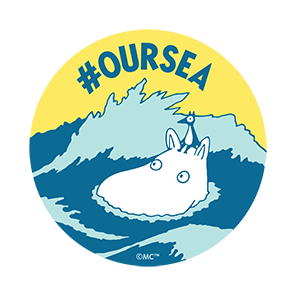#OURSEA – a joint campaign run by Moomin Characters and the John Nurminen Foundation – is raising awareness about the Baltic Sea and the various ways we can help it. The campaign is also seeking to raise funds for the John Nurminen Foundation’s efforts to save the Baltic Sea and its heritage. This blog post will take you on a journey to admire the wonders of summer life in the Baltic Sea!
“Glass-green and white waves rolled in over the sand. Oh, to be a Moomin and to dance in the waves while the sun gets up! The night was forgotten and a long June day lay before them. They dived like porpoises through the waves and sailed in on the crests towards the beach where Sniff was playing in the shallow water. Snufkin was floating on his back far out and looking up into the blue and gold sky.”
Finn Family Moomintroll
When summer comes, the rocks along the shoreline regain their green beards, as annual filamentous algae (such as green algae and sea lettuces) reach full growth.
It’s all action in the sea bays: tiny fry grow up in the shelter of aquatic vegetation, preying on small zooplankton such as water fleas and fish-lice for their first meals. Perch come to spawn in sheltered bays and coves. The spawn will attach itself to aquatic plants in long, thin threads like a bead necklace; and also to the spawning cones that people have lowered into the water to help the perch.
The Baltic Sea’s own seahorses – pipefish such as the broadnosed pipefish and straightnose pipefish – also spawn in the bladderwrack zone. The male carries the eggs in his ventral pouch and takes good fatherly care of them until they hatch. Sheltered by vegetation, Baltic prawns feed in shallow waters where they are easy to observe, if you stay still for a moment.
The nauplius larvae of barnacles swim freely in search of a suitable substrate to which they can attach themselves and continue their lives, such as the surface of a jetty, buoy, rock or bladderwrack. Bladderwrack spores are also searching for a suitable substrate. They will not be able to attach themselves if eutrophication has created a lot of loose material on the seabed, rocks or cliffs. This material also hinders the growth and renewal of bladderwrack forests.
In the heat of July, blue-green algae take advantage of the phosphorus left in the sea from the spring blooming of planktonic algae. In calm weather, they form large blooms on the sea’s surface. Blue-green algae can extract nitrogen nutrients directly from the atmosphere, so their growth can be limited by reducing the amount of phosphorus that ends up in the sea and is available from the water.
Learn more about Baltic Sea fauna
Grass-wrack is a seagrass whose relatives grow in the sands of larger seas. Seagrasses have adapted to marine life – in addition to algae and seaweeds, they are the only plants that can grow in salty water. The seagrass meadows form a unique landscape that is home to a wide range of Baltic Sea dwellers. According to the latest research, these meadows are also effective carbon sinks, just like forests are on land.

Marine pipefish, such as the broadnosed pipefish and straightnose pipefish, are close relatives of seahorses. The broadnosed pipefish has a cunning disguise: you can barely make it out against the swaying leaves of a seagrass meadow. The male broadnosed pipefish cuts a good fatherly figure in the bladderwrack forests, as he protects the eggs laid by the female in his ventral pouch. And even after they’ve hatched, the fry can still escape from danger by diving back into his pouch.

Barnacles are the oldest known invasive species in the Baltic Sea, after arriving on ships from the Americas a couple of hundred years ago. Barnacles attach themselves to a substrate and feed off small creatures that they filter from the water with feathery limbs protruding from their calcite shells. Their abundance has stolen habitat from the Baltic Sea’s indigenous organisms.

Let’s save #OURSEA together
We hope you will join us in securing the future of the Baltic Sea. By combining our forces, we can still save #OURSEA.
Take part in the campaign by making a donation at www.oursea.fi, or by disseminating information on the Baltic Sea and its status.


